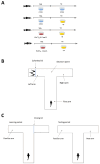The Neurobehavioral Impact of Zinc Chloride Exposure in Zebrafish: Evaluating Cognitive Deficits and Probiotic Modulation
- PMID: 40137520
- PMCID: PMC11945970
- DOI: 10.3390/toxics13030193
The Neurobehavioral Impact of Zinc Chloride Exposure in Zebrafish: Evaluating Cognitive Deficits and Probiotic Modulation
Abstract
Zinc contamination in aquatic environments has become a growing concern due to its potential to bioaccumulate and induce neurotoxic effects in aquatic organisms. As an essential trace element, zinc plays a crucial role in various physiological processes, but excessive exposure can disrupt the gut-brain axis, leading to cognitive and behavioral impairments. Recent studies have suggested that probiotics may offer protective effects against environmental neurotoxins by modulating the gut microbiota and associated neurological functions. The zebrafish (Danio rerio) has emerged as a valuable model organism for studying the biological mechanisms underlying neurotoxicity and potential therapeutic interventions. This study aimed to assess the effects of probiotics on cognitive impairments induced by zinc chloride (ZnCl2) exposure in zebrafish. Specifically, zebrafish were exposed to ZnCl2 at concentrations of 0.5 mg/L and 1.0 mg/L for 96 h, followed by a 7-day post-exposure period to probiotics (Bifidobacterium longum, Bifidobacterium animalis lactis, Lactobacillus rhamnosus). ZnCl2 exposure at these concentrations is already known to induce behavioral and neuromotor deficits resembling Alzheimer's disease-like symptoms in zebrafish models, making it a suitable model for evaluating the neuroprotective potential of probiotics. Behavioral assessments including sociability tests along with short- and long-term memory evaluations were conducted using EthoVision XT 16 software. Memory tests demonstrated that ZnCl2 exposure impaired cognitive functions, while probiotic treatment did not significantly ameliorate these deficits. In the social behavior test, ZnCl2 at 0.5 mg/L resulted in a marked decrease in sociability, whereas exposure to 1.0 mg/L did not induce significant changes. However, post-exposure probiotic administration following ZnCl2 intoxication at 1.0 mg/L exhibited an anxiolytic effect on zebrafish. These findings suggest that probiotics may exhibit partial neurobehavioral benefits following zinc chloride-induced toxicity, particularly in mitigating anxiety-like behaviors rather than cognitive deficits. Further investigations are needed to elucidate the precise mechanisms by which probiotics interact with the gut-brain axis in the context of heavy metal neurotoxicity.
Keywords: behavior; probiotics; toxicity; zebrafish; zinc chloride.
Conflict of interest statement
The authors declare no conflicts of interest.
Figures





References
-
- Zeb M., Khan K., Younas M., Farooqi A., Cao X., Kavil Y.N., Alelyani S.S., Alkasbi M.M., Al-Sehemi A.G. A review of heavy metals pollution in riverine sediment from various Asian and European countries: Distribution, sources, and environmental risk. Mar. Pollut. Bull. 2024;206:116775. doi: 10.1016/j.marpolbul.2024.116775. - DOI - PubMed
-
- Iordache A.M., Nechita C., Voica C., Pluhacek T., Schug K.A. Climate change extreme and seasonal toxic metal occurrence in Romanian freshwaters in the last two decades—Case study and critical review. NPJ Clean Water. 2022;5:2. doi: 10.1038/s41545-021-00147-w. - DOI
-
- Saravanan P., Saravanan V., Rajeshkannan R., Arnica G., Rajasimman M., Baskar G., Pugazhendhi A. Comprehensive review on toxic heavy metals in the aquatic system: Sources, identification, treatment strategies, and health risk assessment. Environ. Res. 2024;258:119440. doi: 10.1016/j.envres.2024.119440. - DOI - PubMed
-
- DHAC: Australian Government Department of Health and Aged Care . Environmental Fate and Effects of Zinc Ions. Australian Government Department of Health and Aged Care; Canberra, Australia: 2024. [(accessed on 7 January 2025)]. Draft Evaluation Statement: EVA00143 [Internet] Available online: https://www.industrialchemicals.gov.au/sites/default/files/2024-04/EVA00....
LinkOut - more resources
Full Text Sources
Research Materials

